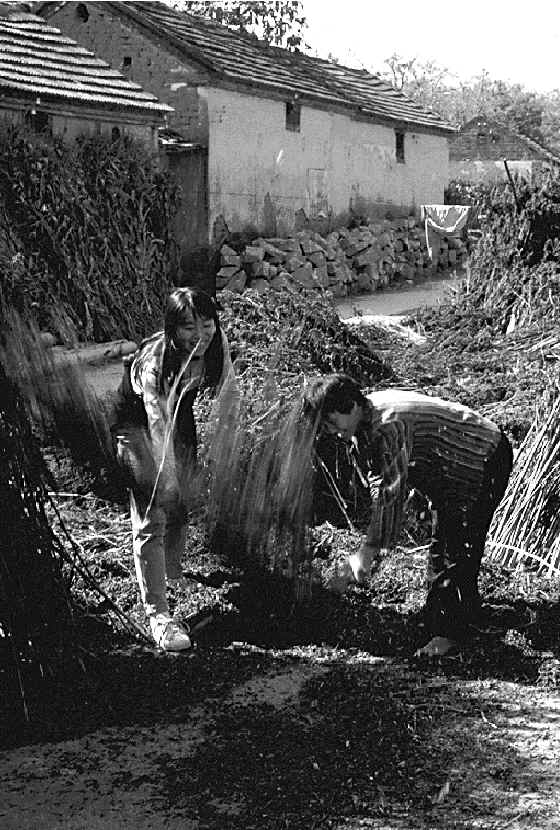
55
Taxonomic studies of Cannabis in China
Shao Hong1 and Robert C. Clarke2
1 Department of Biology
and Genetics, Beijing Medical University, Beijing 100083, PRC
2 Projects Manager, International
Hemp Association, Postbus 75007, 1070 AA Amsterdam, The Netherlands
Shao Hong and Robert
C. Clarke 1996. Taxonomic studies of Cannabis in China. Journal of
the International Hemp Association 3(2): 55-60.
Many aspects of Cannabis taxonomy and
systematics have been studied in the People's Republic of China (PRC) since it was founded
in 1949. Most of the reports indicated that only one species (Cannabis sativa L.)
exists in China and consists of two infra specific taxa (variously indicated either as
subspecies, varieties or forms) sativa and indica. The fiber types
low in THC are classified as subspecies sativa and drug types with higher THC
contents are classified as subspecies indica. These drug varieties are
found south of 42°N latitude in western China and south of 30°N latitude in eastern
China. Since classical taxonomic studies fall short of fully answering questions
about the evolution of Cannabis in China, various molecular methods are
suggested.
Introduction
Cannabis has
spread naturally and has also been cultivated in nearly every province and climatic zone
in China from ancient times to the present. The fibers of Cannabis stalks
are most commonly used to make ropes, clothes and other textiles, while its seeds are
pressed for their oil, or are eaten raw or roasted as snacks between meals (especially in
northwestern Yunnan Province). They are also mixed in buttered tea by Tibetans.
Some Cannabis is illicitly planted for smoking in the Xinjiang Province of
northwestern China. Drug Cannabis is rarely, if ever, applied as a medicine
in Chinese hospitals because it is erroneously considered addicting.
Besides the general name Da Ma (great
hemp), the Chinese vernacular terms for Cannabis include Huo Ma (fire
hemp), Xian Ma (line hemp) and Huang Ma (yellow hemp). The fruits
of Cannabis are called Ma Zi (hemp seed) and Huo Ma Ren (fire
hemp seed). The female inflorescences are called Ma Fen (fragrant hemp
branch). The terms Da Ma, Xian Ma, and Huang Ma for the
plants and their products and Da Ma Zi or simply Ma Zi for the fruits
are usually applied to the fiber and seed producing C. sativa cultivars and
landraces. Cannabis smoking is not popular or widespread in China. The
terms Da Ma and Huo Ma are only rarely used to denote smoking Cannabis
in the south and east of China. However, Huo Ma is much more commonly used
by traditional Chinese pharmacists to denote the cleaned hemp seeds incorporated into
local herbal stomach remedies. The seeds for medical use most often come from either
cultivated or naturalized C. sativa landraces.
Chinese scientists have carried out thorough
research on the genus Cannabis and their articles, published in diverse Chinese
books and journals, cover nearly all aspects of its study from practical agronomy to
public health concerns. This paper concentrates on the literature pertaining
directly to the taxonomy and evolution of the genus Cannabis as well as
supporting literature from the fields of comparative anatomy and morphology, natural
products chemistry, and the most recent tentative approaches to analysis.

History and literature
Contemporary Chinese Cannabis
studies began in the 1950's, soon after the People's Republic of China was founded.
During those days, a general natural resources survey was carried out all over
China. The medicinal and economic values of Cannabis were first recorded in
Flora of Chinese Medicinal Plants (Pei and Chou 1951) and it is also recorded in
the Chinese Pharmacopoeia of 1957. Chinese scientists early noticed that Cannabis
is a widely distributed plant in China and has medical and other productive
applications. Two of the first Chinese books on plant taxonomy, Pictorial
Handbook of Chinese Plants (Chia et al. 1958) and Dictionary of Families
and Genera of Chinese Seed Plants (How 1958), simultaneously named Cannabis from
China as C. sativa L. Since this name was also recorded in Iconographia
Cormophytorum Sinicorum (ASBI 1972), one of the most comprehensive and highly
respected Chinese plant taxonomy reference books, C. sativa L. has been regarded
as the representative name for Chinese Cannabis.
Another form name, C. sativa L. f.
ruderalis (Janisch.) Chu, was recorded in Flora Plantarum Herbacearum Chine
Boreali-Orientalis (Chu 1959). This new form name was also adopted by Flora
of Chinese Economic Plants (Anon. 1961) and specifically represented the Cannabis
distributed in some areas of northeastern China. The specimens representing
this form in Chinese herbaria do not exhibit the key anatomical character described by
Janischevsky (1924), i.e., that the fruit base becomes elongated and forms a
"caruncle". However, his collections from Altai and Yili in Xinjiang
Province possess the so-called "caruncle" only in some fruits from the same
plant. The lack of a caruncle may result from incomplete maturation. Based on
the lack of consistent expression of this primary discriminating character, both the form
name and the original species name are questionable.
Zhao (1991) proposed that there are four
varieties of C. sativa L. distributed in China; sativa, spontanea,
indica and kafiristanica. However, while only presenting a basic
classification key derived from Small and Cronquist (1976), she did not provide Chinese
representative voucher specimens or delimit the range of these taxa except that the
specimens from Fukang, Xinjiang, was identified as spontanea.
The Morphology Department of the Botanical
Institute of the Academia Sinica (ASBI 1960) reported on the pollen surface features of
Chinese Cannabis in Pollen Morphologies of Chinese Plants. The
ASBI Handbook of Chinese Oil Plants (1973) discusses the constituents of Cannabis
seed oil. Other important chemical components of Cannabis such as the
cannabinoids, and the terpenoids which account for its unique aromas, are listed in Lexicon
of Chinese Traditional Medicinal Plants (Jiangsu New Medical College 1975), Compilation
of Chinese Herbal Medicines (Anon. 1978) and Flora of Economic Plants in Shandong
Province (Anon. 1978). Other papers scattered in various journals report the
cannabinoid content of specimens from several provinces (e.g. Ling et al.
1985, Liu et al. 1992, Chen et al. 1993, Zhan et al. 1994).
Large scale comprehensive scientific research
on Cannabis from 1986 through 1990 (encompassing the disciplines of chemistry,
anatomy, morphology, pharmacognosy, drug use survey, etc.) was carried out in several
institutes in a coordinated program organized by the National Institute for the Control of
Pharmaceutical and Biological Products under the organization of the Bureau of Public
Health. The results are collected mostly in Corpus of Scientific Theses on
Cannabis (Anonymous 1991).

Achievements and problems
China is one of the largest
countries in the world, covering over 9.6 million square kilometers. There are
cultivated landraces, feral escapees from cultivation and truly wild Cannabis populations
in China. Chinese Cannabis populations from different locations vary widely
in morphology, chemical contents and levels of biologically active compounds, but much of
the same variation can also be found within single plants at varying stages of
development. Climatic and edaphic conditions also cause wide variation in proposed
taxonomic characters and often confound attempts at accurate systematic analyses.
Collecting and classifying accessions from various conditions of climate, elevation,
microclimate and soil leads to ambiguous results. Since most Cannabis varieties
are dioecious, (the morphologically different male and female flowers are borne on
separate plants), morphological taxonomic decisions should be based on observations of
both staminate and pistillate individuals. However, many herbarium specimens are
collected from juvenile plants and so are devoid of any flowers. It is important to
collect samples during a common developmental "window" (i.e., floral
maturation) so that data can be compared more accurately. This can only be
accomplished by growing accessions in a common garden and carefully sorting herbarium
samples by developmental maturity and sexual type.
Specimens of Chinese Cannabis are
mostly kept in the regional herbaria of the Botanical Institute of the Academia Sinica
(ASBI) and some larger universities. Herbarium specimens and fruits are also
preserved in some institutes and universities at which the studies on Cannabis were
carried out in recent years, such as Beijing Medical University and the National Institute
for the Control of Pharmaceutical and Biological Products. Other Cannabis taxonomic
materials are mostly found in the local departments of the Bureau of Public Health.
Morphological and anatomical studies of
herbarium specimens and living samples of Chinese Cannabis reveal the following
unique observations. Cultivated varieties have significantly larger fruits than the
wild populations. Size of the fruits is only a stable criterion of classification as
to whether samples are cultivated or wild forms, but does not indicate geographical
origin. Surface patterns of the persistent vestigial perianths adherent on the
achenes show some differences between the wild and the cultivated forms. Wild fruits
generally have deeper, and more irregularly dispersed, pigmented areas (blotchy spots and
stripes) than those of the cultivated ones. All other morphological and anatomical
parameters found to vary widely due to environmental influences are not suitable as
criteria for taxonomic and evolutionary studies.
The content of delta-9-THC in fruiting
inflorescences of Chinese Cannabis, from different individual plants, ranges
across a broad scale from 0.02% to 4.38% of dry weight (Zhao 1991, Zhan et al.
1994). THC content can vary widely even among individual samples taken from the same
inflorescence. In addition, THC breaks down slowly at room temperature. This
means that samples must be fresh, large and well-homogenized to provide accurate results.
Landraces cultivated for drug use are generally the highest in THC, while those
cultivated for fiber and seed uses are the lowest in THC. Escaped populations have
THC contents approximating those of the related cultivated populations, and wild
populations generally have low THC contents. According to the forensically-oriented
view of Small and Cronquist (1976), all samples grown for producing Cannabis cigarettes
(Ma Yan) in Xinjiang Province can be classified as members of the
"drug" group (THC greater than 0.3% of dry weight). Therefore, as an
amendment of general opinion, the distribution of Chinese drug type Cannabis might
be expanded to include areas south of 42°N latitude in the Xinjiang Province of western
China, in addition to the regions of southern and eastern China, south of 30°N latitude.
Liu et al. (1992) reported that there
is little or no THC, CBD or CBN in the stems and leaves of male plants both from Shache
and Kashi, Xinjiang, while there are higher contents of THC in the stems and leaves of
female plants from the two areas. They stated that only the female plants contain
medicinal properties or are used for smoking. The upper inflorescences, younger
leaves and resin gland secretions of female plants are used for making Cannabis cigarettes
in Kashi, Hetian and Aksu in Xinjiang. The THC content of Xinjiang Cannabis cigarettes
ranged from 0.42% to 1.06% of dry weight in Kashi Prefecture, and the average THC content
of Cannabis cigarettes from Shache was 0.79% of dry weight (Chen et al.
1993).
The comparative histology of the stalk (Zhao
1991) showed that the average number of vessels in vessel groups of xylem in 40 samples of
Cannabis (sp. and subsp.) from 24 regions of China is variable. This
finding disagrees with the results of Anderson (1974) who found the average numbers of
vessels in vessel groups of xylem in C. sativa and C. indica were 1.39
and 3.05 respectively. However, it must be remembered that what Anderson called C.
indica may have been what Chinese taxonomists usually refer to as C. sativa ssp.
indica, and may also have included samples of what the Russian taxonomists
Vavilov and Bukinich (1929) called C. indica ssp. afghanica or C. indica ssp.
kafiristanica. Chinese herbarium collections do not include any examples of
these taxa. The existence of only a few calcareous crystals in Chinese Cannabis also
differs from Anderson's observations of C. indica.
Experimental taxonomic studies of Cannabis,
including statistics of germination rates of seeds, making artificial hybridizations and
analysis of hereditary characteristics of filial generations, were carried out at Beijing
Medical University from 1990-93, under the supervision of Prof. Cheng Ching-young, one of
the most well-known taxonomists in China. Her results revealed that few important
taxonomic criteria can be used to distinguish the samples from Xinjiang, Gansu, Inner
Mongolia and Ningxia Provinces in northwestern China. From the dissertation of one
of her students (Yang 1993), Cheng concluded that there is only one species (C. sativa
L.) consisting of two forms: (f. sativa and f. indica) in China.
It is possible to distinguish this (as well as more subtle) genetic differences
between cultivated and wild forms by means of further DNA analyses.
Since there are no classical taxonomic
characters suitable to classify species and varieties of Cannabis, other new
appropriate technologies have been introduced into this field. A project using
advanced molecular methods was started at Beijing Medical University in late 1993 (Shao
and Liu 1994). The chromosome number of Cannabis is 2n=20 (Harlan et al.
1973), but there is little information concerning chromosome karyotype, genome or DNA.
Employing the molecular genetic techniques of DNA polymorphisms, the molecular
genetic variations of Chinese Cannabis resources can be better investigated and
the evolutionary relationships between wild populations, landraces, and cultivars can be
revealed.
Data reflecting the relatedness of differing
populations is also valuable to modern plant breeders wishing to utilize diverse gene
pools in the development of modern Cannabis cultivars. The goals of current
work are to: 1) determine the distribution of wild, semi-wild and cultivated Cannabis in
China, 2) compare accessions at the molecular genetic level, 3) determine origins of
cultivated Cannabis taxa and evolutionary relationships between them, as well as
between wild and cultivated taxa, 4) make molecular identification of sex during early
developmental stages of Cannabis, 5) determine the molecular genetic differences
between fiber and drug types of Cannabis and 6) determine the range of genetic
variation in modern landraces and cultivars.
Presently, we have some preliminary
experimental results: 1) The DNA lengths of Cannabis from Yunnan, Guizhou and
Xinjiang Provinces are about 10-20 kilobases. 2) Cultivated samples have mutations in the
DNA structure indicative of artificial selection. 3) DNA restriction fragments are
different between the cultivated samples and the wild samples. 4) The samples of different
sexes exhibit unique identifiable fragments. 5) Identifiable genetic fingerprints exist in
different accessions. Recent discoveries about Cannabis DNA encouraged us
to continue the project, but further achievements must be supported by additional funding.

Prospective endeavors
Considering the difficulties of Cannabis
research, the hidden relationships between Cannabis varieties or populations
require that new and more advanced techniques be introduced and combined with conventional
studies of Cannabis. Following the progress in other disciplines (e.g.,
blood/tissue typing and genome mapping), studies of classification, systematics and
evolution in Cannabis might successfully use modern molecular techniques to solve
problems for which conventional methods are inadequate.
Currently, there are several techniques of DNA
polymorphism analysis successfully used to find genetic correlations, to detect
evolutionary relationships, and to identify a hybrid's possible parents. They have
been concerned with plant taxa ranging from families to varieties, in more than 10
families and 20 genera. These modern molecular techniques include: VNTR (Variable
Number of Tandem Repeats), RFLP (Restriction Fragment Length Polymorphisms), AP-PCR
(Arbitrarily Primed Polymerase Chain Reaction), DAF (DNA Amplification Fingerprint), RAPD
(Random Amplified Polymorphic DNA), etc. Other methods applicable to investigation
of polymorphisms in mitochondrial and chloroplast DNA have also been developed.
These readily available "DNA fingerprint" methods can be used to analyze plant
genomes. Two or more of these DNA data, when compared to each other and to other
taxonomic data, could greatly improve our understanding of the systematics and evolution
of Cannabis.
The Chinese National Natural Science Foundation
has supported some molecular taxonomic and systematic projects that mostly employed the
technology of chloroplast DNA restriction maps to study wild species in Vitis,
the Convallariaceae and Gnetaceae, ferns etc., since 1989 (Qi and Gao 1990 and 1991, Zhu
1992, Zhu and Qi 1993). A few papers about molecular taxonomy and systematics can be
found in Chinese scientific journals (Shi 1993, Hong 1993, Shao and Liu 1994, Huang et
al.). Most are reviews and conclude that modern molecular technologies can be
used to solve plant taxonomic, systematic and evolutionary problems. DNA fingerprint
studies of Chinese Cannabis in Beijing Medical University enlisted the modest
support of the Bureau of Public Health at the end of 1993, but the project is now short of
funds.
We are confident that when the continuing
vigorous development of modern molecular biological techniques is accompanied by
improvement of our financial environment, research on Cannabis in China will
progress greatly and will contribute additional valuable evidence to the studies and
applications of Cannabis worldwide.
References
Interested researchers may request the list of Chinese Cannabis herbarium accessions used to make the distribution map on page 57.